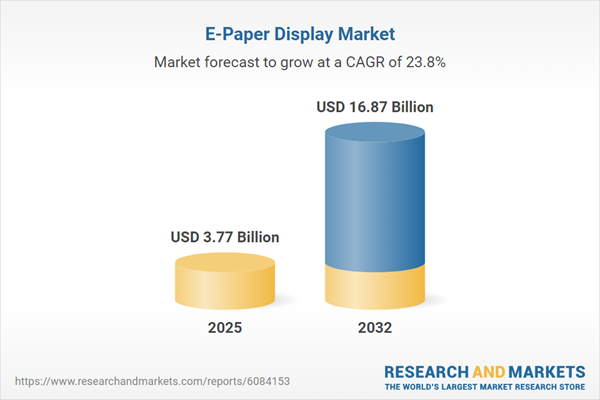Speak directly to the analyst to clarify any post sales queries you may have.
The global e-paper display market stands at a pivotal juncture, with ongoing technological advances and sustainable demands driving fresh opportunities and challenges for senior stakeholders navigating today’s digital display sector.
Market Snapshot: Growth and Opportunity in the E-Paper Display Market
The e-paper display market grew from USD 3.05 billion in 2024 to USD 3.77 billion in 2025. The sector is set for further robust growth at a CAGR of 23.81%, reaching USD 16.87 billion by 2032. Market expansion is supported by widespread adoption across retail, healthcare, government, defense, and consumer electronics. E-paper’s low power consumption and paper-like clarity are aligning strongly with global sustainability initiatives and user experience expectations, making it a key priority for enterprises seeking display solutions with long-term value.
Scope & Segmentation
- Technology: Active Matrix; Passive Matrix—businesses can tailor display performance and cost based on operational need.
- Display Type: Color; Monochrome—display versatility serves both dynamic branding and efficiency objectives.
- Type: Cholesteric Liquid Crystal Displays (ChLCD); Electro-fluidic Displays; Electro-wetting Displays; Electrochromic Displays; Electrophoretic Displays (EPD)—each technology delivers distinct benefits in energy use, flexibility, and visual impact.
- Application: E-Reader; Electronic Shelf Label; Smart Card; Smart Label; Asset Tracking; Inventory Management; Ticketing—e-paper’s role extends from digital pricing to logistics oversight.
- End Use: Consumer Electronics; Government & Defense; Healthcare & Medical; Diagnostic Equipment; Monitoring Devices; Wearables; Industrial; Retail; Transportation—solution adaptability enables penetration into diverse operating environments.
- Geographic Coverage: Americas (including United States, Canada, Mexico, Brazil, Argentina, Chile, Colombia, Peru); Europe, Middle East & Africa (spanning United Kingdom, Germany, France, Russia, Italy, Spain, Netherlands, Sweden, Poland, Switzerland, United Arab Emirates, Saudi Arabia, Qatar, Turkey, Israel, South Africa, Nigeria, Egypt, Kenya); Asia-Pacific (featuring China, India, Japan, Australia, South Korea, Indonesia, Thailand, Malaysia, Singapore, Taiwan) — global reach positions the e-paper display market for variable regional growth.
- Key Companies: Mouser Electronics, Inc.; Orient Display; Unisystem; Ynvisible Interactive Inc.; Evelta Electronics; BOE Varitronix Limited; EL International Ltd; Sharp NEC Display Solutions Europe GmbH; Display Logic USA; Advantech Co., Ltd.—market leadership is dispersed across leading hardware and integration providers.
Key Takeaways for Senior Decision-Makers
- Progress in material science and advanced pixel architectures are shaping higher industry standards across performance areas, including refresh rates and display clarity.
- Both passive and active matrix display technologies address specific operational strategies, enabling flexibility in deployment from static to frequent-update environments.
- Emerging modalities such as color e-paper, electro-wetting, and electro-fluidic technologies are accelerating market expansion beyond traditional applications and opening new verticals.
- To mitigate cost pressures and regulatory disruption, companies are realigning supply frameworks—emphasizing local assembly and strategic sourcing initiatives for greater responsiveness.
- Sustainability is a central driver, prompting innovation in recyclable substrates and eco-oriented manufacturing to comply with evolving procurement standards and regulations worldwide.
- Fully integrated solutions that interface e-paper hardware with software and cloud-based analytics are increasingly favored by enterprises seeking scalable, recurring value from their technology investments.
Tariff Impact: Navigating US Measures and Global Value Chains
Recent US tariff shifts have increased component costs, motivating manufacturers to innovate in supply chain management and diversify procurement. Regional assembly and multi-partner collaborations now play a larger role in reducing risk. Organizations investing in supply chain intelligence are better positioned to manage pricing volatility and maintain operational continuity amid shifting trade policies.
Methodology & Data Sources
This report relies on a mixed-methods approach, combining primary interviews with industry experts, quantitative surveys, and a review of published research, patents, and regulatory filings. Data integrity is strengthened by subject matter peer review to ensure reliable analysis.
Why This Report Matters
- Delivers actionable market insights for senior stakeholders considering strategic opportunities, procurement, or competitive positioning within the e-paper display sector.
- Clarifies the implications of technology trends, regulatory policies, and emerging operational demands to support informed investment or expansion planning.
- Enables benchmarking across regions, applications, and display types so leaders can anticipate market challenges and capture growth potential.
Conclusion
The e-paper display market is progressing quickly, providing enterprises with expanded capabilities and unique operational considerations. Decision-makers will benefit from these insights as they guide their organizations through technological advancements and industry change.
Table of Contents
3. Executive Summary
4. Market Overview
7. Cumulative Impact of Artificial Intelligence 2025
Companies Mentioned
The companies profiled in this E-Paper Display market report include:- Mouser Electronics, Inc.
- Orient Display
- Unisystem
- Ynvisible Interactive Inc.
- Evelta Electronics
- BOE Varitronix Limited
- EL International Ltd
- Sharp NEC Display Solutions Europe GmbH
- Display Logic USA.
- Advantech Co., Ltd.
Table Information
| Report Attribute | Details |
|---|---|
| No. of Pages | 188 |
| Published | October 2025 |
| Forecast Period | 2025 - 2032 |
| Estimated Market Value ( USD | $ 3.77 Billion |
| Forecasted Market Value ( USD | $ 16.87 Billion |
| Compound Annual Growth Rate | 23.8% |
| Regions Covered | Global |
| No. of Companies Mentioned | 11 |









